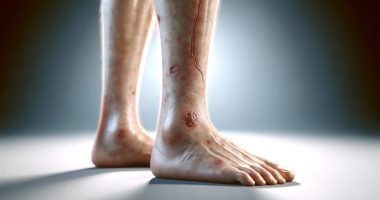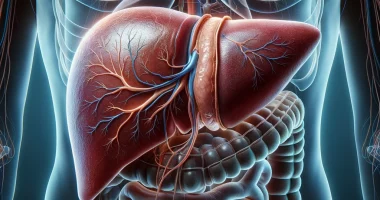Hallux rigidus
Definition
Hallux rigidus is stiffness of the 1st toe due to osteoarthritis of the 1st metatarsophalangeal joint. It is manifested by significant limitation of mobility and pain syndrome. Pain increases when walking, negatively affecting the ability to work and the ability to move. Often, there is a deformation of the joint due to the growth of osteophytes and inflammation of the surrounding tissues. Pathology is diagnosed based on complaints, external examination data, and radiography results. At the initial stage, treatment is conservative (massage, physiotherapy, medications), and later surgery is indicated.
General information
Hallux rigidus is the second most common orthopedic foot disease after hallux valgus. The incidence increases with age. The pathology is detected in 10% of people under 35. At the age of over 80 years, it is diagnosed in 44% of patients. With bilateral lesions, a hereditary predisposition is usually traced. Unilateral process more often develops after trauma.
Causes
Experts consider deforming osteoarthritis to be the main cause of hallux rigidus. The following factors are considered as triggering factors of arthrosis:
- anatomical features of the 1st metatarsal bone (long or raised bone);
- neuromuscular pathologies involving the foot;
- joint hypermobility;
- traumatic injuries;
- surgical interventions;
- rheumatoid arthritis;
- gout;
- dissecting osteochondritis.
Hallux rigidus is often found in blood relatives, indicating a hereditary predisposition. Transverse flat feet, wearing uncomfortable and high-heeled shoes, prolonged standing, and excessive weight have an unfavorable effect. Degenerative-dystrophic changes in the joints worsen with age, so older people suffer more often.
Classification
In modern traumatology and orthopedics, systematization is used to determine the tactics for treating stiff joints, taking into account the severity of the process. The angle of dorsiflexion of the thumb, the nature of changes on radiographs, and clinical symptoms of the disease are considered the main parameters. The classification includes five stages:
- Stage 0. Flexion 40-60 degrees (10-20% less than normal). The radiologic picture is unchanged. Symptoms are absent.
- Stage 1. Bending 30-40 degrees. Images show a slight decrease in the articular gap, flattening of the metatarsal head, and osteophytes on the dorsal surface. Pain is insignificant or intermittent.
- Stage 2. Bending 10-30 degrees. Radiographs show moderate narrowing of the joint gap, osteosclerosis, and bone overgrowths on all surfaces. Pain is frequent and moderately pronounced. Hallux rigidus causes discomfort when walking.
- Stage 3. Flexion is less than 10 degrees. Radiographically, significant narrowing of the articular gap, periarticular cysts, and involvement of sesamoid bones are determined. The pain is prolonged, severe, and constant. There is non-intense pain during passive movements in the medial range.
- Stage 4. Clinical and radiologic signs are the same as in stage 3. Sharp pain occurs when attempting passive movements.
Symptoms
The disease develops gradually. At first, the patient notes a slight dull pain in the joint after prolonged walking or standing. Then, the joint becomes swollen, and pain appears during walking and persists at rest for a long time. Progressive limitation of movements becomes noticeable, restricting the choice of shoes and excluding the possibility of wearing high heels.
Due to pain and reduced range of motion, the biomechanics of walking are disturbed. The patient rolls over the outer edge of the foot rather than the entire foot, making the gait unsteady and somewhat clumsy. Pain in the distal part of the foot and the fifth metatarsophalangeal joint may occur due to overloading the outer edge of the foot.
Pain and reduced range of motion continue to progress. Pain syndrome occurs at night, significantly limiting the patient’s motor activity. In the final stages, walking in normal shoes becomes difficult. Movement in the joint is usually absent. Palpation is painful. The base of the big toe is visually deformed due to inflammation and large bony overgrowths.
Diagnosis
The diagnosis is determined by an orthopedic traumatologist. Complaints, anamnestic data, physical examination results, and additional tests are used during diagnostics. The examination program includes:
- Patient survey. The specialist identifies factors that may have provoked the development of the disease, determines when and under what circumstances the pain appeared, and determines the nature and duration of the pain syndrome and its relationship to external conditions.
- Objective examination. At the early stages of examination, the joint is externally unchanged or insignificantly changed. Later, visible deformity, bony overgrowths on the dorsum and outer surface, skin thickening, and signs of inflammation are detected. Movement is limited. At later stages, even with minor passive movements, there is pain.
- Radiograph of the foot. The articular gap is narrowed. The contours of the articular ends of the bones are uneven, and osteophytes are detected. Foci of rarefaction due to the formation of cysts can be seen in the bone tissue.
Other instrumental studies are usually not required. In doubtful cases, a CT scan of the foot may be performed to clarify the nature and severity of the lesion. A rigid metatarsophalangeal joint is differentiated with pain syndrome in valgus deformity of the big toe and gouty arthritis.
Treatment
Conservative therapy is possible in the initial stages. If stiffness progresses and conservative measures are ineffective, surgical intervention with preservation or removal of the affected joint is required.
Conservative therapy
It is indicated at stages 0 and 1 of the disease. It aims to eliminate the symptoms, does not affect pathology causes, and does not provide full recovery. Includes the following techniques:
- Protective regimen. Patients are recommended to avoid prolonged walking and prolonged standing and wear comfortable shoes. If they must stay on their feet for a long time, they should take breaks to rest their feet.
- Orthotic devices. Individual selection of orthopedic insoles to support the arch of the foot and metatarsophalangeal joint. Individual orthopedic shoes are made according to the indications.
- Non-medicamentous methods. Patients are prescribed courses of massage and training in self-massage. It is recommended to regularly perform sports for the muscles of the foot and lower leg.
- Physiotherapy. Electrophoresis with novocaine is effective for pain. Ultrasound, laser therapy, magnetotherapy, andshockwave therapy are used to eliminate inflammation, improve local metabolism, and stimulate tissue repair.
- Drug treatment. NSAIDs of local and general action are indicated for pain and signs of inflammation. In case of persistent pain syndrome, blockades with glucocorticoid agents are performed.
Surgical interventions
All surgical methods used for hallux rigidus can be divided into two groups – those involving the preservation of the joint with the restoration of its function and those involving the removal of the articular surfaces with the creation of a fixed joint or replacement with an endoprosthesis. The following interventions are most commonly performed:
- Removal of osteophytes (cheilectomy). The joint-preserving method of correction is the excision of bone overgrowths to restore joint mobility. It is recommended in stages 1 and 2.
- Osteotomy. Kessel-Bonney and Waterman’s surgeries are variants of wedge osteotomy of the first metatarsal bone, which increase the volume of movement by changing the joint configuration. They are complemented by the removal of bone overgrowths. The method is effective in stages 1-2.
- Arthroplasty. The operation’s essence is the partial removal of the thumb’s main phalanx. The technique is used in 3-4 stages in elderly patients. In the postoperative period, traction is performed to create a scar connection while maintaining the finger’s functionally favorable position.
- Arthrodesis. The “gold standard” treatment for stiff thumb. The articular surfaces of the bones are excised, and the bones are fused together. After fusion, the joint disappears, and a fixed joint is formed. The method eliminates pain syndrome and ease of walking at stages 3 and 4.
- Endoprosthetics. The articular surfaces are replaced with metal or plastic implants. The long-term results of the intervention still need to be studied, so the technique is used only in middle-aged and older adults with moderate or insignificant physical activity.
The period of full recovery after a cheilectomy takes about a month. During this time, the patient should limit the load on the foot. The rehabilitation period after other surgeries is 6-8 weeks. Afterward, all patients are recommended to use special insoles or orthopedic shoes.
All these treatment options are available in more than 760 hospitals worldwide (https://doctor.global/results/diseases/hallux-rigidus). For example, Hallux rigidus surgery can be done in these countries at following approximate prices:
Turkey$1.4 K in 29 clinics
Germany$6.3 K in 45 clinics
China$7.1 K in 6 clinics
United States$7.7 K – 18.9 K in 23 clinics
Israel$9.1 K in 16 clinics.
Prognosis
The formation of hallux rigidus indicates a long-term pathological process in the joint. Full recovery is impossible, but conservative measures can slow the progression of the disease, and surgical interventions ensure the disappearance of foot pain and preservation of the ability to work.
Prevention
Preventive measures include preventing injuries and early treatment of joint diseases that may cause osteoarthritis. It is recommended to normalize body weight, wear comfortable shoes, avoid overloading the foot, and use orthopedic insoles if there is a family predisposition.

